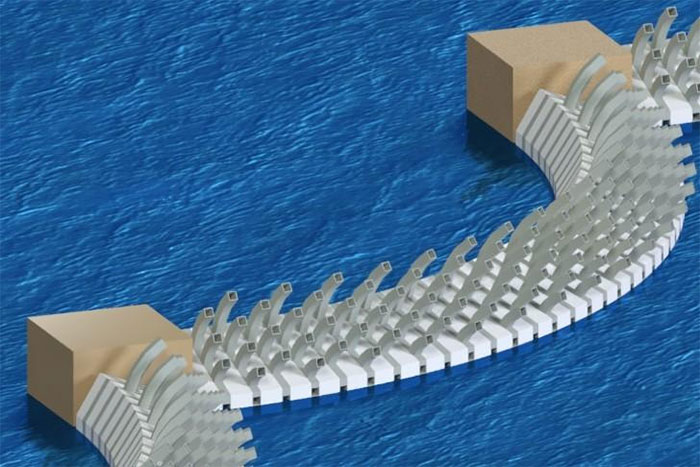Australia developed floating dikes to block waves and storms
'Artificial floating forests' developed by Australian engineers are flexible fences of concrete and plastic pipes of many kilometers in length to eliminate waves and reduce the winds of storms.
According to New Atlas, typhoons cause serious damage to coastal areas, eroding shorelines and destroying infrastructure such as marinas. However, a newly proposed "floating forest" can help by blocking both wind and waves. Australian engineers have developed flexible barriers that cover kilometers of wave destruction.

The floating forest will have a sloping surface with "artificial floating forests".
Australian engineers call them giant breakwaters with steep surfaces that resemble a ramp, causing waves to dissipate their energy without causing damage.
To counteract the wind, the concrete structure was attached with a 'forest' of several rows of 20m long plastic pipes. They are made of concrete and plastic. This design retains flexibility and at the same time allows to combat wind, reduce wind speed and disrupt nearshore winds. Moreover, water will flow into the hollow tube dissipating wave energy.
Floating 'forest' technology is patented by University of Queensland inventors, who hope to one day apply the technology on the shores of Bangladesh, Mozambique, Taiwan and the Philippines, countries that are often through a storm. At the same time, they are building a small clone to test in the pool with artificial waves. Professor Chien Ming Wang, the project's lead author, said the engineers had developed breakwaters to lower the wave heights, but there was still nothing to hold the wind back. For the first time, they put such a windbreak on a floating rack.
Scientists say that, due to global warming, ocean and ocean storms have become more intense, threatening coastal infrastructure. And by the end of the century, one should prepare for storms reaching speeds of 370km / h.
- 10 spectacular scenes in the storm
- Super tropical storm Debbie landed Australia, sea waves higher than 2m
- Floating houses on the sea can resist strong storms of level 4
- Finding new sound waves accelerates the treatment of lung and diabetes diseases more than 60 times
- An Gianh: Planting vetiver grass to protect embankments, river banks, dikes
- Super waves appear more and more
- Can take X-rays of the Earth by storm
- Anti-drowning hat
- 10 beautiful floating buildings in the world
- Big storms appear in Central America and the Caribbean
- Australia developed artificial intelligence to decipher mysterious sound signals from the universe
- Huge stone symbol of Australia suddenly turned into a waterfall
 The US company is about to build a supersonic passenger plane of 6,000km / h
The US company is about to build a supersonic passenger plane of 6,000km / h Japan develops avatar robot as in fiction film
Japan develops avatar robot as in fiction film Australia tested the world's first mango picking robot
Australia tested the world's first mango picking robot America develops technology to separate water from animal waste
America develops technology to separate water from animal waste